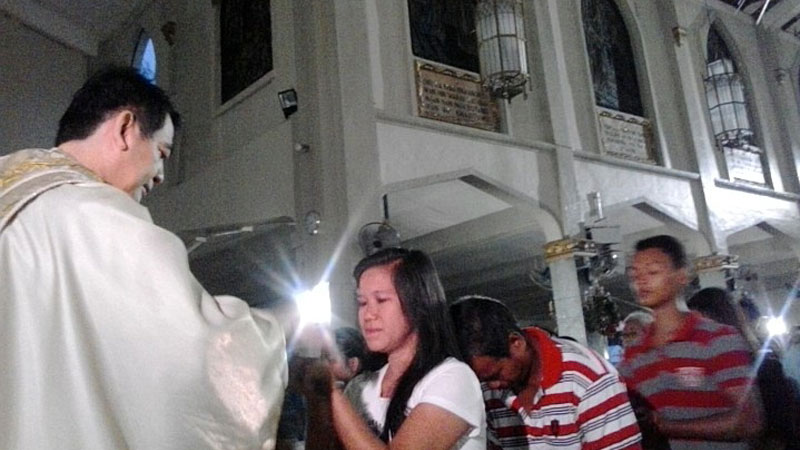Wet church, warm hearts in Tacloban

KEEPING THE FAITH. Msgr. Alex Opiniano gives Holy Communion to the faithful during the first “Misa de Gallo” at Sto.Niño de Tacloban Church a month after Supertyphoon “Yolanda” laid the city to waste. SHIENA BARRAMEDA/INQUIRER SOUTHERN LUZON
TACLOBAN CITY—With only a light green-and-yellow checkered shawl to protect her from the chill and slight drizzle, 89-year-old Damasa Pelingon trudged with her daughter, Delia, through unlit streets before daybreak on Monday to reach Sto. Niño de Tacloban Church.
Like some 500 survivors of Supertyphoon “Yolanda” (international name: “Haiyan”), which ripped this once-progressive city into shreds, the Pelingons were attending the first of nine “Misa de Gallo” (dawn Masses) to contribute their own prayers of gratitude that they are still alive and will be able to spend Christmas together at their temporary shelter.
It did not matter that the two women were far from wearing their Sunday best that day. Damasa was in a golden yellow polo shirt and brown skirt that reached the ankles. Delia wore a collared, long-sleeve pink blouse and white slacks.
Shod in slippers, they walked 400 meters from Divine Word Hospital, where some of the survivors are staying.
Stronger spirit
Article continues after this advertisementSigns of Yolanda’s onslaught are still visible in the church as everywhere else in the capital and its people. Tarpaulin sheets blanket portions of the church roof that were blown away by the Nov. 8 typhoon, but these failed to keep rainwater from pouring inside during the Mass.
Article continues after this advertisementOn Sunday night, some 300 residents braved the rain to attend the first “Simbang Gabi”—proof that their spirit is stronger than bad weather.
During his Misa de Gallo homily, Mgsr. Alex Opiniano, parish priest of the church, said the people of Tacloban should see the effects of monster typhoon Yolanda as an opportunity to start all over again.
“A crisis is a cry for change. It is a challenge for us to change for the better,” he said.
He pointed out that the absence of glittery and fancy decorations traditionally associated with a Filipino Christmas should be interpreted as an opportunity for the survivors to get to know themselves better and further understand the true essence of the holidays.
The lack of distractions allows people to get in touch with themselves and reflect on the relationships they now have, Opiniano said. “We pray more solemnly when stripped with comforts that we are used to.”
During Simbang Gabi on Sunday, Fr. Isagani Petilos, assisting priest of Sto. Niño de Tacloban, praised the strength and faith shown by the residents after the typhoon.
The Simbang Gabi at 6 p.m. will be held for nine days until Dec. 23. On the other hand, the Misa de Gallo at 4:30 a.m. started on Monday and will end on Christmas Eve.
Gratitude for survival
Maria Liza Paredes, 48, a mother of two, said she attended the first Misa de Gallo without any wish in mind unlike most Filipinos.
“I do not intend to complete the entire nine days of Misa de Gallo. I’m just here to say my thanks,” she said. She expressed gratitude for her family’s survival during the storm surge that washed away their house in one of the coastal villages of Tacloban.
Delia, 65, a retired elementary school teacher, was also thankful her mother, Damasa, was able to celebrate her birthday last week, despite having very little food and belongings. The storm surge swamped their 40-year-old house in Barangay (village) Paterno.
“I hope there will still be relief before Christmas Day. I will cook our noche buena from whatever they will give us,” Delia said.
The two women said they were still looking forward to the traditional midnight Christmas meal as a way of adding normalcy to their lives.
Maria Chrisma Paredes, 26, a resident of Barangay 31 and wife of the head village watchman, said the storm swept away all their belongings but would rely on relief items to prepare a “proper” Christmas celebration with their daughter Jenny Rose, 5.
“I will make do with sardines and noodles. The important thing is that we are all together, alive and well,” Paredes said.